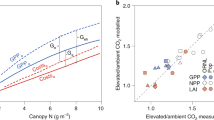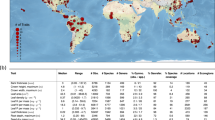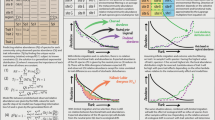Abstract
Organizing principles are needed to link organismal, community and ecosystem attributes across spatial and temporal scales. Here we extend allometric theory—how attributes of organisms change with variation in their size—and test its predictions against worldwide data sets for forest communities by quantifying the relationships among tree size–frequency distributions, standing biomass, species number and number of individuals per unit area. As predicted, except for the highest latitudes, the number of individuals scales as the -2 power of basal stem diameter or as the -3/4 power of above-ground biomass. Also as predicted, this scaling relationship varies little with species diversity, total standing biomass, latitude and geographic sampling area. A simulation model in which individuals allocate biomass to leaf, stem and reproduction, and compete for space and light obtains features identical to those of a community. In tandem with allometric theory, our results indicate that many macroecological features of communities may emerge from a few allometric principles operating at the level of the individual.
This is a preview of subscription content, access via your institution
Access options
Subscribe to this journal
Receive 51 print issues and online access
$199.00 per year
only $3.90 per issue
Buy this article
- Purchase on Springer Link
- Instant access to full article PDF
Prices may be subject to local taxes which are calculated during checkout





Similar content being viewed by others
References
Brown, J. H. Macroecology (Univ. Chicago Press, Chicago, 1995).
Rosenzweig, M. L. Species Diversity in Space and Time (Cambridge Univ. Press, Cambridge, 1995).
Whittaker, R. H. Communities and Ecosystems 2nd edn (Macmillan, New York, 1975).
Tilman, D. & Pacala, S. in Species Diversity in Ecological Communities: Historical and Geographical Perspectives (eds Ricklefs, R. E. & Schluter, D.) 13–25 (Univ. Chicago Press, Chicago, 1993).
Huston, M. A. Biological Diversity (Cambridge Univ. Press, Cambridge, 1994).
Whittaker, R. J. Scaling, energetics and diversity. Nature 401, 865–866 (1999).
Ritchie, M. E. & Olff, H. Spatial scaling laws yield a synthetic theory of biodiversity. Nature 400, 557–560 (1999).
MacArthur, R. H. & Wilson, E. O. The Theory of Island Biogeography (Princeton University Press, Princeton, 1967).
Terborgh, J. On the notion of favorableness in plant ecology. Am. Nat. 107, 481–450 (1973).
Tilman, D. Causes, consequences and ethics of biodiversity. Nature 405, 208–211 (2000).
Tilman, D., Lehman, C. L., & Thomson, K. T. Plant diversity and ecosystem productivity: Theoretical considerations. Proc. Natl Acad. Sci. USA 94, 1857–1861 (1997).
Gross, K. L., Willig, M. R., Grough, L., Inouye, R. & Cox, S. B. Patterns of species diversity and productivity at different scales in herbaceous plant communities. Oikos 89, 417–427 (2000).
Huston, M. A. et al. No consistent effect of plant diversity on productivity. Science 289, 1255a http://www.sciencemag.org/cgi/reprint/289/5483/1255a (2000).
West, G. B., Brown, J. H. & Enquist, B. J. A general model for the structure and allometry of plant vascular systems. Nature 400, 664–667 (1999).
Niklas, K. J. Plant Allometry (Univ. Chicago Press, Chicago, 1994).
Enquist, B. J., Brown, J. H. & West, G. B. Allometric scaling of plant energetics and population density. Nature 395, 163–165 (1998).
Enquist, B. J., West, G. B., Charnov, E. L. & Brown, J. H. Allometric scaling of production and life-history variation in vascular plants. Nature 401, 907–911 (1999).
Niklas, K. J. & Enquist, B. J. Invariant scaling relationships for interspecific plant biomass production rates and body size. Proc. Natl Acad. Sci. USA 98, 2922–2927 (2001).
Roy, K., Jablonski, D. & Martien, K. K. Invariant size–frequency distributions along a latitudinal gradient in marine bivalves. Proc. Natl Acad. Sci. USA 97, 13150–13155 (2000).
Whittaker, R. H. & Woodwell, G. M. Dimension and production relations of trees and shrubs in the Brookhaven Forest, New York. J. Ecol. 56, 1–25 (1968).
White, J. The allometric interpretation of the self thinning rule. J. Theor. Biol. 89, 475–500 (1981).
Brown, S. Estimating biomass and biomass change of tropical forests. Food and Agricultural Organization of the United Nations Forestry Paper 134 (Rome, 1997).
Morse, D. R., Lawton, J. H., Dodson, M. M. & Williamson, M. H. Fractal dimension of vegetation and the distribution of arthropod body lengths. Nature 314, 731–733 (1985).
Damuth, J. Population density and body size in mammals. Nature 290, 699–700 (1981).
Niklas, K. J. Size-dependent variations in plant growth rates and the “3/4-power rule”. Am. J. Bot. 81, 134–144 (1994).
Barenblatt, G. I. & Monin, A. S. Similarity principles for the biology of pelagic animals. Proc. Natl Acad. Sci. USA 80, 3540–3542 (1983).
De Liocourt, F. De l'aménagement des sapinières (Bulletin de la Société Forestière de Franche-Comte et Belfort, Besançon, 1898).
Gentry, A. H. Changes in plant community diversity and floristic composition on environmental and geographic gradients. Ann. Miss. Bot. Gar. 75, 1–34 (1988).
Gentry, A. H. in Biodiversity and Conservation of Neotropical and Montane Forests (eds Churchill, S. P. et al.) 103–126 (New York Botanical Garden, New York, 1993).
Waring, R. H., Landsberg, J. & Williams, M. Net primary production of forests: A constant fraction of gross primary production? Tree Physiol. 18, 129–134 (1998).
Valentini, R. et al. Respiration as the main determinant of carbon balance in European forests. Nature 404, 861–865 (2000).
Okubo, A & Levin, S. A. A theoretical framework for data analysis of wind dispersal of seeds and pollen. Ecology 70, 329–338 (1989).
Jack, S. B. & Long, J. N. Linkages between silviculture and ecology: an analysis of density management diagrams. Forest Ecol. Manag. 86, 205–220 (1996).
Cannell, M. G. R. World Forest Biomass and Primary Production Data (Academic, New York, 1982).
Olson, J. S., Watts, J. A. & Allison, L. J. Major World Ecosystem Complexes Ranked by Carbon in Live Vegetation: A Database CDIC Numeric Data Collection NDP-01 7 (Oak Ridge National Laboratory, Oak Ridge, 1985).
Niklas, K. J. The Evolutionary Biology of Plants (Univ. Chicago Press, Chicago, 1997).
Niklas, K. J. The evolution of plant body plans—a biomechanical perspective. Ann. Bot. 85, 411–438 (2000).
Niklas, K. J. Morphological evolution through complex domains of fitness. Proc. Natl Acad. Sci. USA 91, 6772–6779 (1994).
Reich, P. B., Walters, M. B. & Ellsworth, D. S. From tropics to tundra: Global convergence in plant functioning. Proc. Natl Acad. Sci. USA 94, 13730–13734 (1997).
Elser, J. J. et al. Biological stoichiometry from genes to ecosystems. Ecol. Lett. 3, 540–550 (2000).
Acknowledgements
We thank D. Ackerly, J. Ackerman, J. Brown, W. Chaloner, K. Harms, J. Haskell, D. Post, T. Phillips, P. Stoll, J. Valentine, R. Whittaker, J. Williams and M. Willig for discussions or comments on the manuscript; J. Miller, P. Raven and the Missouri Botanical Garden for help in disseminating the Gentry database; and J. Pringle and A. Landcaster for programming assistance with SWARM. This work stems in part from the Body Size in Ecology and Evolution Working Group sponsored by The National Center for Ecological Analysis and Synthesis (NCEAS, a centre funded by the NSF, the University of California Santa Barbara and the State of California). In particular we wish to acknowledge J. Haskell for critical help with the Gentry data; G. West and B. Tiffney for support; and F. Smith and the members of the body size working group for their input to this project. B.J.E. was supported by the NSF, the Santa Fe Institute and NCEAS. K.J.N. was supported by an Alexander von Humboldt Forschungspreis and NYS Hatch grant funds.
Author information
Authors and Affiliations
Corresponding author
Supplementary information
Supplementary Information
Supplementary Information
Rights and permissions
About this article
Cite this article
Enquist, B., Niklas, K. Invariant scaling relations across tree-dominated communities. Nature 410, 655–660 (2001). https://doi.org/10.1038/35070500
Received:
Accepted:
Issue Date:
DOI: https://doi.org/10.1038/35070500
This article is cited by
-
An equation of state unifies diversity, productivity, abundance and biomass
Communications Biology (2022)
-
Solving the grand challenge of phenotypic integration: allometry across scales
Genetica (2022)
-
New approach to calculating tree height at the regional scale
Forest Ecosystems (2021)
-
Stage-dependent plasticity in biomass allocation and allometry in response to population density in Abutilon theophrasti: a step forward to understanding the nature of phenotypic plasticity
Plant Ecology (2021)
-
Resource ephemerality influences effectiveness of altruistic behavior in collective foraging
Swarm Intelligence (2021)
Comments
By submitting a comment you agree to abide by our Terms and Community Guidelines. If you find something abusive or that does not comply with our terms or guidelines please flag it as inappropriate.



